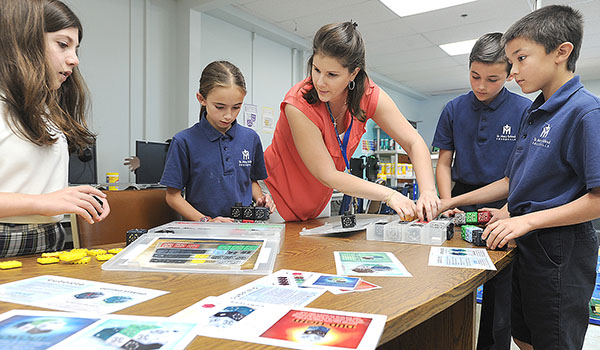St. Mary School plans special space for tech learning
by PATRICK J. BUECHI
There's a buzz in Swormville. The staff of St. Mary's School has been busy as bees to get a special dedicated space for their technology program.
Grants from Upon This Rock and an anonymous foundation have allowed the pre-K through eighth-grade school to convert two classrooms into a tech-friendly space that would allow students to use any of a number of electronics, cameras and even toys to solve problems and communicate their solutions addressed in each of their classes.
The room, set to open this fall, will be a Makerspace. Described as a community center with tools, Makerspaces combine manufacturing equipment, community and education for the purpose of enabling students to design, prototype and manufacture works that could not be possible by someone working alone.
St. Mary has nicknamed their space the HIVE, with the hopes that the room will be a place of hands on discovery, innovation, vision and exploration.
"We think that's an appropriate standard for the space," said Shannon Federowicz, technology teacher for the school.
The space, which will open in the fall, is the vision of Federowicz, STREAM coordinator Katie Bishop and Principal Mary Jo Aiken, who began planning and writing grants last November. It will be used for Project-Based Learning, where students are given a real-world challenge, then research and design a way to present their knowledge on tackling the issue. Seventh-grade students read "A Long Walk to Water," the real-life story of living in a desert and having to carry jugs of water for miles to a home village. In math they figure out the carrying capacity. In gym they experience the physical side by carrying jugs. In the HIVE, they will engineer a better way to gather water, then build a prototype of their design.
"They have to build around it. They may have to code around it. They may have to build a 3-dimentional representation. They may have to do electronics and circuitry," said Aiken, explaining that creativity and imagination will drive the students' projects.
The students will have an animation studio, complete with green screens and camcorders to tell their story, along with robotics, stackable coding Cubelets, K'nex and even good old cardboard on hand.
"The creativity is in the kids. They're born with it, but this allows them to manifest their creativity," explained Aiken.
"When they are very young, they just want to build," said Bishop. "If we can tie that into the curriculum and encourage that, maybe that child will grow up and become an engineer."
Aiken calls the space a "New Age shop class" and the way to use it as "New World teaching."
"The old paradigm for teachers was you have a curriculum, the children sit in seats and absorb. This is active learning, and teachers, themselves, have to be engaged in order to do it. Teachers have to be willing to grow," she said.
The teachers are now facilitators, assisting students rather than lecturing.
"If you had told me 10 years ago that I would be teaching engineering, I would have laughed in your face. But it's really less about what I'm doing and more about what they're doing. I present the challenge and the materials and they do the work," Bishop said. "I facilitate and I ask questions, but it's really kind of freeing once you can let go and embrace it."
Federowicz compares it to the parable of teaching a man to fish and they can fish forever.
"From what I've heard, job interviewers are looking at team work and the four Cs - creativity, critical thinking, communication, collaboration, instead of just 'Can I memorize these facts.' It's 'Can I problem solve? Can I work with other people?' That's what we're trying to teach them," said Bishop.
"The communication part of those four Cs, is not just communication among the children, but it's their ability to present what they've built, what they've achieved, and to bring that to others and to present it in a coherent matter. It's good all the way around for developing those important skills that they are going to use into their adulthood," added Aiken.
The team of educators at the school seem to have the Four C's mastered. They work well together, often finishing each other's sentences and completing their thoughts. They don't think this new way of learning is too heavy a load for young students.
"I think they crave it," said Bishop.
"It's natural for them to be curious," said Federowicz.
"And engaged," added Aiken.
"I think it make learning more real for them," concluded Bishop.
The kids who were born into a tech-friendly world want to figure out how it works in the same way their parents took apart radios to learn what made them tick.
"Kids these days don't just consume the technology, they produce it. They want to create it, they want to be the next big thing," said Federowicz.
"They want to hack it," added Bishop.
They're now reaching out to the community seeking engineers and computer programmers to speak to the students. An employee from Lockheed Martin came in as a guest speaker.
"I really feel like, if our students have that now, when they get to high school, they're going to be teaching other students and they're going to be thriving, even more so then they already are. I think they will set them a part," said Bishop. "It's crazy to think about them in college and careers, but that's what we have to do as educators."
The team said the grant writing process went pretty smoothly, with members of the diocesan Department of Catholic Education and the Foundation of the Roman Catholic Diocese of Buffalo Grants Committee helping. They had to prove they were meeting other standards in the diocese and that STREAM was in the budget, before receiving the $9,000 grant. Another $2,000 came from an anonymous foundation.




